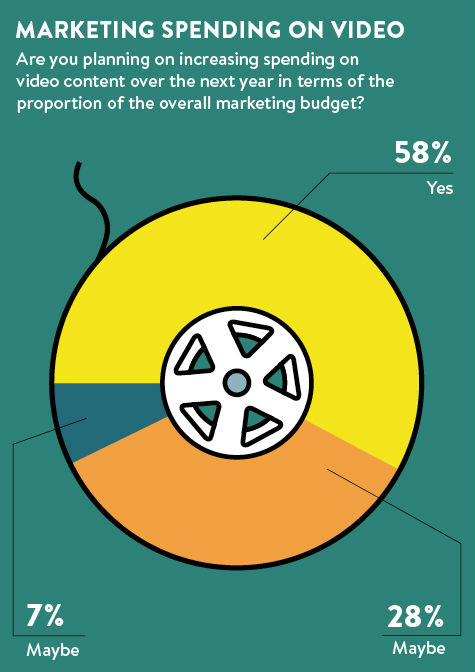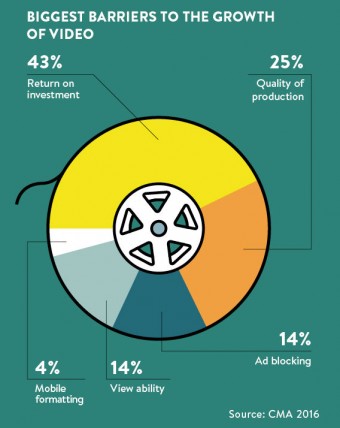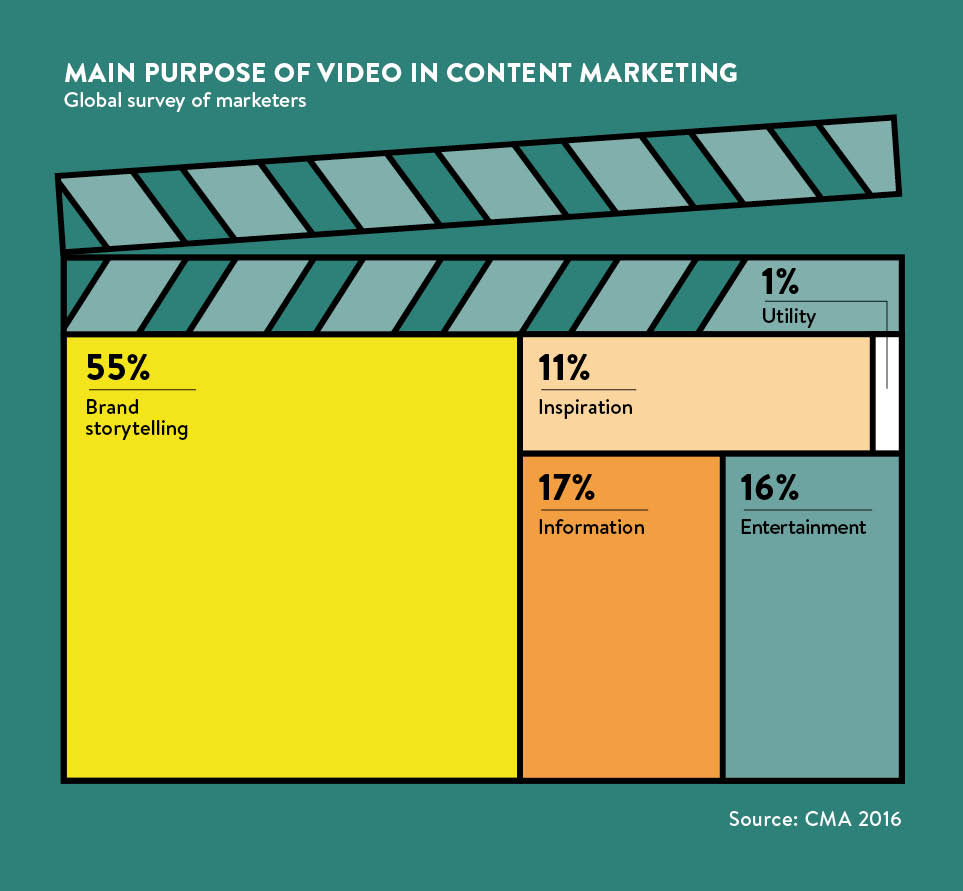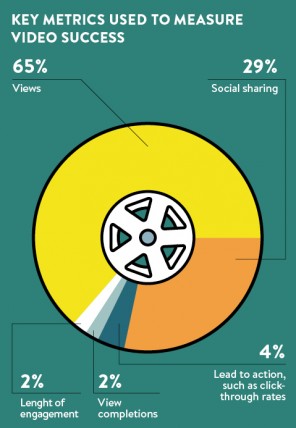Video is hot property these days. It’s one of the fastest-growing types of online content and that growth comes on an already strong foundation. There’s no shortage of statistics supporting the meteoric rise of video as a tool for individuals and businesses to communicate, from Facebook’s reported eight billion daily video views to the hundreds of hours of content uploaded to YouTube every minute.
What’s more, this growth is set to continue, with Cisco predicting that video will account for more than 80 per cent of consumer internet traffic by 2020, at which point it would take you more than five million years to watch the amount of video that will cross global IP networks every month.
Why wouldn’t businesses want to capitalise on this? The power of storytelling, informing and entertaining is at the heart of how brands can connect with their customers, and the social nature of video offers opportunities not just to reach the customers you know, but to have them share your content with audiences you don’t.
 What’s more, production costs have fallen as new tools and technologies make the process of video creation, editing and publishing ever simpler, while the platforms to ensure your content reaches its intended audience have increased dramatically. Today’s marketer has a wealth of options at their disposal, from video platforms such as YouTube and Vimeo, to social networks such as Facebook, LinkedIn and Instagram, and new live broadcasting platforms such as Periscope, Vine and Facebook Live.
What’s more, production costs have fallen as new tools and technologies make the process of video creation, editing and publishing ever simpler, while the platforms to ensure your content reaches its intended audience have increased dramatically. Today’s marketer has a wealth of options at their disposal, from video platforms such as YouTube and Vimeo, to social networks such as Facebook, LinkedIn and Instagram, and new live broadcasting platforms such as Periscope, Vine and Facebook Live.
“The most successful brands are those that can be great publishers and content creators, and provide innovative, relevant content for their audiences to consume,” says Thierry Campet, global head of marketing communications at UBS Wealth Management. “At UBS we have created a new thought-leadership platform called UNLIMITED*, designed to create compelling content that echoes with our clients’ daily priorities in life, beyond investment. Video has played a significant role in helping us achieve this, extending our reach and allowing us to broach innovative topics like Iceland’s new digital currency, Auroracoin, in a beautifully engaging and creative way.”
Yes, most of us will have heard of viral video hits such as Evian’s dancing baby, Jean-Claude Van Damme and Volvo Trucks or Volkswagen’s Darth Vader commercial. Most of us can acknowledge that they are entertaining and their audience figures are impressive. But not every business wants or needs millions of video views, nor is it realistic to expect every business to be able to leverage video content to achieve viral success or social fame.
While few would question the volume of video content being created and consumed, many remain uncertain of how to assess the value of this medium for businesses
In the quest to reach new audiences, views and shares have often been used as a proxy for success and return on investment (ROI), yet in many cases these figures alone don’t tell the whole story. Video views on their own may be impressive, but if they’re based on the wrong people watching your content, or not enough of them taking the desired action afterwards, the investment won’t deliver the desired outcome.
 One of the main stumbling blocks in creating video content is starting with the idea first, rather than the business challenge you’re trying to solve. Businesses can often be tempted into investing in online video content because competitors have done so, because an internal stakeholder is keen on it or simply because it’s considered in vogue. Video may indeed be part of the right solution, but starting with the business issue at hand will ensure you set the right key performance indicators for your video investments and connect them back to the challenge they are designed to address.
One of the main stumbling blocks in creating video content is starting with the idea first, rather than the business challenge you’re trying to solve. Businesses can often be tempted into investing in online video content because competitors have done so, because an internal stakeholder is keen on it or simply because it’s considered in vogue. Video may indeed be part of the right solution, but starting with the business issue at hand will ensure you set the right key performance indicators for your video investments and connect them back to the challenge they are designed to address.
“Shared ownership is a complex subject matter,” says Alice Turner, marketing and property events manager for housing association and Property Marketing Awards winner L&Q. “Before creating our PricedIn website, we found that a large proportion of our buyers were left feeling somewhat bamboozled by shared ownership and often none the wiser as to whether it was right for them.
“Video allows us to convey detailed information quickly and effectively through an engaging medium, ensuring viewers are fully clued up on the subject and know that they are eligible, prior to registering. Buying your first home is a very personal experience, it can also be overwhelming; being able to gather impartial hands-on information from a mortgage adviser through a video shared on Facebook, or hearing vox pops from real buyers on YouTube, really eases that process for our buyers.
“Visitors who watch video content spend three times longer on our website, demonstrating high engagement levels, and since incorporating video content, we’ve seen a significant increase in the quality of our leads. The majority of people who now register for shared ownership via our website are eligible for the scheme, purely as a result of our audience being better informed. Our video advert from March 2016, which was virally seeded and promoted via social media, contributed to an 11-fold increase in leads from our website compared to the previous year.”
It’s also important to remember that online video isn’t just a medium that can be used to increase product or brand awareness, or generate sales leads and inquiries. One of the most powerful uses of video in recent years has been customer support and customer service.
One of the most powerful uses of video in recent years has been customer support and customer service
Online survey software platform SurveyGizmo avoids the cost and operational complexity of telephone-based customer support by combining an online chat facility with a bank of “how to” videos, designed to help customers to self-serve. This helps to focus contact with advisers on the more complex or technical queries and enables customers to get the answers to more straightforward questions without having to wait for advisers to be available during fixed office hours.

Starting with the business challenge that in the case of customer support may be reducing call or e-mail volumes or waiting times, a business can evaluate its investment in customer support video beyond volume-based metrics, such as views or likes, and look at whether this corresponds with an improvement in wider metrics, which is ultimately what the video content is there to achieve.
 Whatever the business driver is for creating video content, however, there’s one critical ingredient to generating ROI: integration. While businesses may look at channels and media in isolation, consumers rarely have the same perspective.
Whatever the business driver is for creating video content, however, there’s one critical ingredient to generating ROI: integration. While businesses may look at channels and media in isolation, consumers rarely have the same perspective.
For most businesses, video content will be part of a campaign tapestry which might include website, digital advertising, paid and organic social media, as well as potential offline channels, such as a salesforce or events. Attempting to evaluate the ROI of any of these activities in isolation may yield distorted results and lead to ill-advised decisions about future investment because customers simply don’t navigate campaigns in that way.
You may watch an online video seeded on Facebook, but navigate directly to that brand’s website sometime later rather than through a promoted link or you may avoid the website and instead look up other social channels for the brand. You may not “like” a video on YouTube, but you may share it on Twitter or Facebook of your own accord.
While there may be common paths that consumers take through your content, it’s important to recognise that different people will engage in different ways – and that creates a challenge for evaluating ROI on video alone. It’s therefore essential to have a single, holistic view of how online video works in concert with other channels and media, to ensure you’re seeing the full picture. After all, knowing I watched your video is one thing, but knowing what I did next is even more important.




